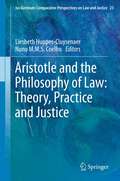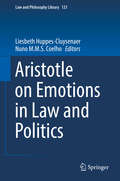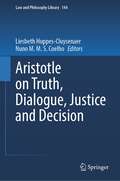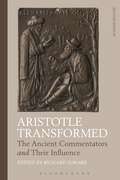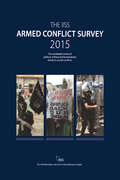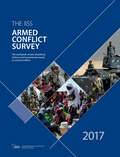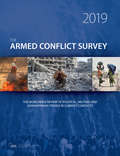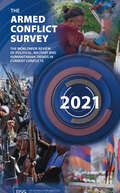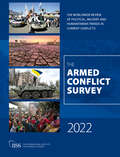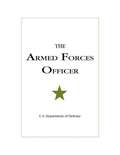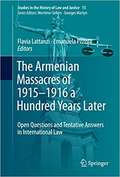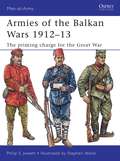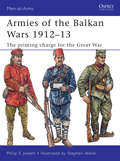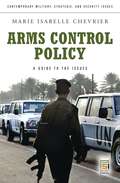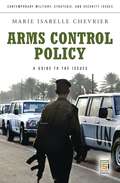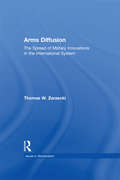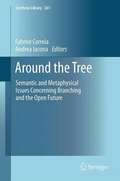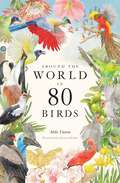- Table View
- List View
Aristotle and The Philosophy of Law: Theory, Practice and Justice (Ius Gentium: Comparative Perspectives on Law and Justice)
by Liesbeth Huppes-Cluysenaer and Nuno M.M.S. CoelhoThe book presents a new focus on the legal philosophical texts of Aristotle, which offers a much richer frame for the understanding of practical thought, legal reasoning and political experience. It allows understanding how human beings interact in a complex world, and how extensive the complexity is which results from humans’ own power of self-construction and autonomy. The Aristotelian approach recognizes the limits of rationality and the inevitable and constitutive contingency in Law. All this offers a helpful instrument to understand the changes globalisation imposes to legal experience today.The contributions in this collection do not merely pay attention to private virtues, but focus primarily on public virtues. They deal with the fact that law is dependent on political power and that a person can never be sure about the facts of a case or about the right way to act. They explore the assumption that a detailed knowledge of Aristotle's epistemology is necessary, because of the direct connection between Enlightened reasoning and legal positivism. They pay attention to the concept of proportionality, which can be seen as a precondition to discuss liberalism.
Aristotle on Emotions in Law and Politics (Law and Philosophy Library #121)
by Liesbeth Huppes-Cluysenaer Nuno M.M.S. CoelhoIn this book, experts from the fields of law and philosophy explore the works of Aristotle to illuminate the much-debated and fascinating relationship between emotions and justice. Emotions matter in connection with democracy and equity – they are relevant to the judicial enforcement of rights, legal argumentation, and decision-making processes in legislative bodies and courts. The decisive role that emotions, feelings and passions play in these processes cannot be ignored – not even by those who believe that emotions have no legitimate place in the public sphere. A growing body of literature on these topics recognizes the seminal insights contributed by Aristotle. This book offers a comprehensive analysis of his thinking in this context, as well as proposals for inspiring dialogues between his works and those written by a selection of modern and contemporary thinkers. As such, the book offers a valuable resource for students of law, philosophy, rhetoric, politics, ethics and history, but also for readers interested in the ongoing debate about legal positivism and the relevance of emotions for legal and political life in today’s world.
Aristotle on Truth, Dialogue, Justice and Decision (Law and Philosophy Library #144)
by Liesbeth Huppes-Cluysenaer Nuno M. M. S. CoelhoIn this thought-provoking book, you’ll find timeless questions explored through a fresh lens. First delving into the profound significance of Socrates’ dialogical method and the inescapable nature of conflict, it ponders the rational capacities of humanity in terms of establishing harmonious communities. But this isn’t merely a philosophical debate; it’s a pragmatic exploration of real-world challenges.No longer limiting itself to abstract theories, the book then seeks to navigate the practical terrain of science and politics. Drawing inspiration from Aristotle, renowned for his investigations into the intricate connections between theory, technology, ethics, and politics, it tackles the essential question: How can we reconcile divergent views?At the book’s core lies Aristotle’s revolutionary concept of dialogue, which portrays truth as a delicate equilibrium between opposing forces, transcending the rigid boundaries of true and false. Join this captivating journey as the author reveals the hidden paths to meaningful coexistence in a world filled with conflicting perspectives.
Aristotle Transformed: The Ancient Commentators and Their Influence
by Richard SorabjiThis book brings together twenty articles giving a comprehensive view of the work of the Aristotelian commentators. First published in 1990, the collection is now brought up to date with a new introduction by Richard Sorabji. New generations of scholars will benefit from this reissuing of classic essays, including seminal works by major scholars, and the volume gives a comprehensive background to the work of the project on the Ancient Commentators on Aristotle, which has published over 100 volumes of translations since 1987 and has disseminated these crucial texts to scholars worldwide.The importance of the commentators is partly that they represent the thought and classroom teaching of the Aristotelian and Neoplatonist schools and partly that they provide a panorama of a thousand years of ancient Greek philosophy, revealing many original quotations from lost works. Even more significant is the profound influence – uncovered in some of the chapters of this book – that they exert on later philosophy, Islamic and Western. Not only did they preserve anti-Aristotelian material which helped inspire Medieval and Renaissance science, but they present Aristotle in a form that made him acceptable to the Christian church. It is not Aristotle, but Aristotle transformed and embedded in the philosophy of the commentators that so often lies behind the views of later thinkers.
Aristotle Transformed: The Ancient Commentators and Their Influence
by Richard SorabjiThis book brings together twenty articles giving a comprehensive view of the work of the Aristotelian commentators. First published in 1990, the collection is now brought up to date with a new introduction by Richard Sorabji. New generations of scholars will benefit from this reissuing of classic essays, including seminal works by major scholars, and the volume gives a comprehensive background to the work of the project on the Ancient Commentators on Aristotle, which has published over 100 volumes of translations since 1987 and has disseminated these crucial texts to scholars worldwide.The importance of the commentators is partly that they represent the thought and classroom teaching of the Aristotelian and Neoplatonist schools and partly that they provide a panorama of a thousand years of ancient Greek philosophy, revealing many original quotations from lost works. Even more significant is the profound influence – uncovered in some of the chapters of this book – that they exert on later philosophy, Islamic and Western. Not only did they preserve anti-Aristotelian material which helped inspire Medieval and Renaissance science, but they present Aristotle in a form that made him acceptable to the Christian church. It is not Aristotle, but Aristotle transformed and embedded in the philosophy of the commentators that so often lies behind the views of later thinkers.
Armed Conflict Survey (Armed Conflict Survey Ser.)
by Nigel InksterThis book provides data on fatalities, refugees and separated people for all major armed conflicts in the Middle East, Sub-Saharan Africa, South Asia, Asia-Pacific, Europe and Eurasia, and Latin America in 2015, alongside in-depth analysis of their political, military and humanitarian dimensions.
Armed Conflict Survey (Armed Conflict Survey Ser.)
by The International The International Institute for Strategic Studies (IISS),This book provides data on fatalities, refugees and separated people for all major armed conflicts in the Middle East, Sub-Saharan Africa, South Asia, Asia-Pacific, Europe and Eurasia, and Latin America in 2015, alongside in-depth analysis of their political, military and humanitarian dimensions.
Armed Conflict Survey 2017 (Armed Conflict Survey Ser.)
by The International Institute for Strategic StudiesThe Armed Conflict Survey provides in-depth analysis of the political, military and humanitarian dimensions of all major armed conflicts, as well as data on fatalities, refugees and internally displaced persons. Compiled by the IISS, publisher of The Military Balance, it is the standard reference work on contemporary conflict. The book assesses key developments in 36 conflicts, including those in Iraq, Syria, Afghanistan, South Sudan, Israel–Palestine, Southern Thailand, Colombia and Ukraine.The Armed Conflict Survey also features chapters on UN peacekeeping; sexual violence; the Islamic State’s shifting narrative; governance by armed groups and rebel-to-party transitions.
Armed Conflict Survey 2017 (Armed Conflict Survey Ser.)
by The International The International Institute for Strategic Studies (IISS),The Armed Conflict Survey provides in-depth analysis of the political, military and humanitarian dimensions of all major armed conflicts, as well as data on fatalities, refugees and internally displaced persons. Compiled by the IISS, publisher of The Military Balance, it is the standard reference work on contemporary conflict. The book assesses key developments in 36 conflicts, including those in Iraq, Syria, Afghanistan, South Sudan, Israel–Palestine, Southern Thailand, Colombia and Ukraine.The Armed Conflict Survey also features chapters on UN peacekeeping; sexual violence; the Islamic State’s shifting narrative; governance by armed groups and rebel-to-party transitions.
Armed Conflict Survey 2019
by The International Institute for Strategic StudiesThe Armed Conflict Survey provides in-depth analysis of the political, military and humanitarian dimensions of all major armed conflicts, as well as data on fatalities, refugees and internally displaced persons. Compiled by the IISS, publisher of The Military Balance, it is the standard reference work on contemporary conflict. The book assesses key developments in 36 high-, medium- and low-intensity conflicts, including those in Iraq, Syria, Afghanistan, South Sudan, Israel–Palestine, Southern Thailand, Colombia and Ukraine. The Armed Conflict Survey features essays by some of the world’s leading experts on armed conflict, including Mats Berdal, Elisabeth Jean Wood, Julia Bleckner, Nelly Lahoud, William Reno and Carrie Manning. They write on: • UN peacekeeping; • conflict-related sexual violence; • the Islamic State’s shifting narrative; • the changing foundations of governance by armed groups; and • rebel-to-party transitions. The authors’ discussion of principal thematic and cross-national trends complements the detailed analysis of each conflict at the core of the book. The Armed Conflict Survey also includes maps, infographics and multi-year data, as well as the IISS Chart of Conflict.
Armed Conflict Survey 2019
by The International The International Institute for Strategic Studies (IISS)The Armed Conflict Survey provides in-depth analysis of the political, military and humanitarian dimensions of all major armed conflicts, as well as data on fatalities, refugees and internally displaced persons. Compiled by the IISS, publisher of The Military Balance, it is the standard reference work on contemporary conflict. The book assesses key developments in 36 high-, medium- and low-intensity conflicts, including those in Iraq, Syria, Afghanistan, South Sudan, Israel–Palestine, Southern Thailand, Colombia and Ukraine. The Armed Conflict Survey features essays by some of the world’s leading experts on armed conflict, including Mats Berdal, Elisabeth Jean Wood, Julia Bleckner, Nelly Lahoud, William Reno and Carrie Manning. They write on: • UN peacekeeping; • conflict-related sexual violence; • the Islamic State’s shifting narrative; • the changing foundations of governance by armed groups; and • rebel-to-party transitions. The authors’ discussion of principal thematic and cross-national trends complements the detailed analysis of each conflict at the core of the book. The Armed Conflict Survey also includes maps, infographics and multi-year data, as well as the IISS Chart of Conflict.
Armed Conflict Survey 2021
by The International Institute for Strategic StudiesThe Armed Conflict Survey is the annual review of the political, military and humanitarian dimensions of all active conflicts from the International Institute for Strategic Studies. It offers in-depth analysis of the drivers, dynamics and outlook of 34 current armed conflicts along with detailed information on conflict parties and more than 60 full-colour maps and infographics. The Armed Conflict Survey is an essential resource for those involved in security, foreign and humanitarian policymaking, and an indispensable handbook for anyone conducting serious analysis of armed conflict. Key features · Essays on global trends in armed conflict, with a focus on the changing nature of third-party intervention, the long aftermath of armed conflicts, and economic migration and forced displacement in a COVID-19 world. · Overviews of key events and political and military developments from January 2020–February 2021 for each conflict. · Strategic analysis of national and regional drivers and conflict outlooks. · Regional analyses with unique insights into the geopolitical and geo-economic threads linking conflicts across regions and globally. · Expanded information on conflict parties. · The Armed Conflict Global Relevance Indicator (ACGRI), an IISS proprietary indicator that combines measures of incidence and human impact with geopolitical impact to assess the global salience of armed conflicts. · Analysis of the humanitarian, social and economic impact of conflicts. · Conflict-specific trends, strategic implications and prospects for peace. · More than 60 full-colour maps, tables and infographics highlighting key conflict developments and data. · Key statistics on violent events, fatalities, military power, geopolitical salience, refugees and internally displaced persons. · The 2021 Chart of Armed Conflict, presenting information on conflict start dates, typologies and relevant refugee flows, as well as providing a visual overview of each conflict’s geopolitical relevance, looking at 2020 UN Security Council resolutions, multilateral missions and the involvement of third-party countries.
Armed Conflict Survey 2021
by The International The International Institute for Strategic Studies (IISS)The Armed Conflict Survey is the annual review of the political, military and humanitarian dimensions of all active conflicts from the International Institute for Strategic Studies. It offers in-depth analysis of the drivers, dynamics and outlook of 34 current armed conflicts along with detailed information on conflict parties and more than 60 full-colour maps and infographics. The Armed Conflict Survey is an essential resource for those involved in security, foreign and humanitarian policymaking, and an indispensable handbook for anyone conducting serious analysis of armed conflict. Key features · Essays on global trends in armed conflict, with a focus on the changing nature of third-party intervention, the long aftermath of armed conflicts, and economic migration and forced displacement in a COVID-19 world. · Overviews of key events and political and military developments from January 2020–February 2021 for each conflict. · Strategic analysis of national and regional drivers and conflict outlooks. · Regional analyses with unique insights into the geopolitical and geo-economic threads linking conflicts across regions and globally. · Expanded information on conflict parties. · The Armed Conflict Global Relevance Indicator (ACGRI), an IISS proprietary indicator that combines measures of incidence and human impact with geopolitical impact to assess the global salience of armed conflicts. · Analysis of the humanitarian, social and economic impact of conflicts. · Conflict-specific trends, strategic implications and prospects for peace. · More than 60 full-colour maps, tables and infographics highlighting key conflict developments and data. · Key statistics on violent events, fatalities, military power, geopolitical salience, refugees and internally displaced persons. · The 2021 Chart of Armed Conflict, presenting information on conflict start dates, typologies and relevant refugee flows, as well as providing a visual overview of each conflict’s geopolitical relevance, looking at 2020 UN Security Council resolutions, multilateral missions and the involvement of third-party countries.
Armed Conflict Survey 2022
by The International Institute for Strategic StudiesThe Armed Conflict Survey 2022 provides an exhaustive review of the political, military and humanitarian dimensions of 33 active armed conflicts globally in the period from 1 March 2021 to 30 April 2022. The review is complemented by a strategic analysis of national, regional and global drivers and conflict outlooks, providing unique insights into the geopolitical and geo-economic threads linking conflicts across the world, as well as into emerging flashpoints and political risks. This edition includes a special feature on climate security given the increasingly urgent need to understand the complex interlinkages between climate change, climate vulnerability and conflict amid accelerating global warming. Reflecting the growing importance of geopolitical factors in the current global conflict landscape, The Armed Conflict Survey 2022 features the IISS Armed Conflict Global Relevance Indicator, which compares the global relevance of armed conflicts in terms of their geopolitical impact, as well as their human impact and intensity. This edition also includes maps, infographics and key statistics, as well as the accompanying Chart of Armed Conflict.
Armed Conflict Survey 2022
The Armed Conflict Survey 2022 provides an exhaustive review of the political, military and humanitarian dimensions of 33 active armed conflicts globally in the period from 1 March 2021 to 30 April 2022. The review is complemented by a strategic analysis of national, regional and global drivers and conflict outlooks, providing unique insights into the geopolitical and geo-economic threads linking conflicts across the world, as well as into emerging flashpoints and political risks. This edition includes a special feature on climate security given the increasingly urgent need to understand the complex interlinkages between climate change, climate vulnerability and conflict amid accelerating global warming. Reflecting the growing importance of geopolitical factors in the current global conflict landscape, The Armed Conflict Survey 2022 features the IISS Armed Conflict Global Relevance Indicator, which compares the global relevance of armed conflicts in terms of their geopolitical impact, as well as their human impact and intensity. This edition also includes maps, infographics and key statistics, as well as the accompanying Chart of Armed Conflict.
The Armed Forces Officer
by U.S. Department of DefenseThis edition is a classic series of books of the same title. These books have provided a foundation of thought, conduct, standards, and duty for American commissioned officers. Available now to the general public, this new edition takes the series inspirational premise into the new century. It educates officers of all services, as well as civilians, about the fundamental moral-ethical requirements of being a commissioned officer in the armed forces of the United States.
The Armenian Massacres of 1915–1916 a Hundred Years Later: Open Questions and Tentative Answers in International Law (Studies in the History of Law and Justice #15)
by Flavia Lattanzi Emanuela PistoiaThis peer-reviewed book features essays on the Armenian massacres of 1915-1916. It aims to cast light upon the various questions of international law raised by the matter. The answers may help improve international relations in the region. In 1915-1916, roughly a million and a half Armenians were murdered in the territory of the Ottoman Empire, which had been home to them for centuries. Ever since, a dispute between Armenians and Turkey has been ongoing over the qualification of the massacres. The contributors to this volume examine the legal nature and consequences of this event. Their investigation strives to be completely neutral and technical. The essays also look at the broader issue of denial. For instance, in Turkey, public speech on the matter can still trigger criminal prosecution whereas in other European States denial of genocide, war crimes and crimes against humanity is criminalized. However, the European Court of Human Rights views criminal prosecution of denial of the Armenian massacres as unlawful. In addition, one essay considers a state’s obligation to remember by looking at lessons learnt from the Inter-American Court of Human Rights. Another contributor looks at a collective right to remember and some ideas to move forward towards a solution. Moreover, the book explores the way the Armenian massacres have affected the relationship between Turkey and the European Union.
Armies of the Balkan Wars 1912–13: The priming charge for the Great War (Men-at-Arms)
by Stephen Walsh Philip JowettIn 1912, the Balkan states formed an alliance in an effort to break free from the crumbling Ottoman Empire. Forming an army of some 645,000 troops from Greece, Bulgaria, Serbia and Montenego, they took on a force of 400,000 Turkish soldiers. Both sides were equipped with the latest weapons technology. This book looks at the diverse and sometimes colourful uniforms worn by both sides, paying special attention to insignia, weapons and equipment. It also gives an overview of the campaigns that became a 'priming pan' of World War I.
Armies of the Balkan Wars 1912–13: The priming charge for the Great War (Men-at-Arms #466)
by Stephen Walsh Philip JowettIn 1912, the Balkan states formed an alliance in an effort to break free from the crumbling Ottoman Empire. Forming an army of some 645,000 troops from Greece, Bulgaria, Serbia and Montenego, they took on a force of 400,000 Turkish soldiers. Both sides were equipped with the latest weapons technology. This book looks at the diverse and sometimes colourful uniforms worn by both sides, paying special attention to insignia, weapons and equipment. It also gives an overview of the campaigns that became a 'priming pan' of World War I.
Arms Control Policy: A Guide to the Issues (Contemporary Military, Strategic, and Security Issues)
by Marie Isabelle ChevrierIn this work, an expert on biological weapons offers a thoughtful examination of the political and technical issues that have affected the implementation of arms control agreements from the 1960s to the present.Arms Control Policy: A Guide to the Issues examines the history of the major arms control treaties since the early 1960s. It offers readers a broad understanding of the ways in which arms control agreements were negotiated and implemented during the Cold War, the international and national events that affected treaty negotiation and implementation, and how the arms control landscape has changed in the war's aftermath. Specifically, the handbook overviews the obligations contained in bilateral U.S.-Soviet/Russian and multilateral arms control agreements covering nuclear and nonnuclear weapons. It also treats such agreements as the Biological Weapons Convention, the Chemical Weapons Convention, the Treaty to Ban Land Mines, and the Treaty to Ban Cluster Munitions. The book concludes with a look at the current challenges in the implementation of arms control agreements and the future of arms control.
Arms Control Policy: A Guide to the Issues (Contemporary Military, Strategic, and Security Issues)
by Marie Isabelle ChevrierIn this work, an expert on biological weapons offers a thoughtful examination of the political and technical issues that have affected the implementation of arms control agreements from the 1960s to the present.Arms Control Policy: A Guide to the Issues examines the history of the major arms control treaties since the early 1960s. It offers readers a broad understanding of the ways in which arms control agreements were negotiated and implemented during the Cold War, the international and national events that affected treaty negotiation and implementation, and how the arms control landscape has changed in the war's aftermath. Specifically, the handbook overviews the obligations contained in bilateral U.S.-Soviet/Russian and multilateral arms control agreements covering nuclear and nonnuclear weapons. It also treats such agreements as the Biological Weapons Convention, the Chemical Weapons Convention, the Treaty to Ban Land Mines, and the Treaty to Ban Cluster Munitions. The book concludes with a look at the current challenges in the implementation of arms control agreements and the future of arms control.
Arms Diffusion: The Spread of Military Innovations in the International System (Issues in Globalization)
by THomas W. ZarzeckiWeapons proliferation is one of the most pressing global concerns following the end of the Cold War. Despite the absence of an overarching superpower conflict, armaments and related technologies have continued to spread throughout the international system. This has been particularly true in areas like East Asia and the Middle East, where the traditional two party arms races are not readily apparent. This text addresses these concerns and shortcomings using data on fourteen specific military technological innovations that diffused throughout the international system from 1960 to 1997.
Arms Diffusion: The Spread of Military Innovations in the International System (Issues in Globalization)
by THomas W. ZarzeckiWeapons proliferation is one of the most pressing global concerns following the end of the Cold War. Despite the absence of an overarching superpower conflict, armaments and related technologies have continued to spread throughout the international system. This has been particularly true in areas like East Asia and the Middle East, where the traditional two party arms races are not readily apparent. This text addresses these concerns and shortcomings using data on fourteen specific military technological innovations that diffused throughout the international system from 1960 to 1997.
Around the Tree: Semantic and Metaphysical Issues Concerning Branching and the Open Future (Synthese Library #361)
by Fabrice Correia Andrea IaconaOver the past few years, the tree model of time has been widely employed to deal with issues concerning the semantics of tensed discourse. The thought that has motivated its adoption is that the most plausible way to make sense of indeterminism is to conceive of future possibilities as branches that depart from a common trunk, constituted by the past and the present. However, the thought still needs to be further articulated and defended, and several important questions remain open, such as the question of how actuality can be understood and formally represented in a branching framework. The present volume is intended to be a 360 degree reflection on the tree model. The contributions is gathers concern the model and its alternatives, both from a semantic and from a metaphysical point of view.
Around the World in 80 Birds
by Mike UnwinThis beautiful and inspiring book tells the stories of 80 birds around the world: from the Sociable Weaver Bird in Namibia which constructs huge, multi-nest 'apartment blocks' in the desert, to the Bar-headed Goose of China, one of the highest-flying migrants which crosses the Himalayas twice a year.Many birds come steeped in folklore and myth, some are national emblems and a few have inspired scientific revelation or daring conservation projects. Each has a story to tell that sheds a light on our relationship with the natural world and reveals just how deeply birds matter to us.
